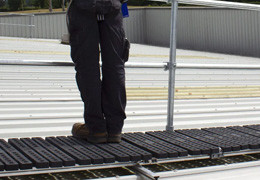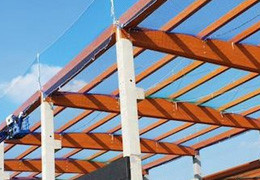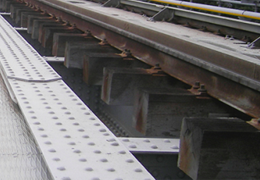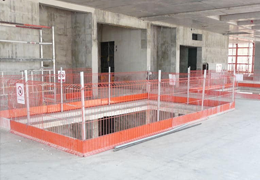In the construction sector there are various situations in which there is a risk of people and objects falling from...
Blog Search
Latest posts
-
 Regulations applicable to work at heightRead more ...
Regulations applicable to work at heightRead more ... -
 Fall protection in civil engineeringRead more ...
Fall protection in civil engineeringRead more ...In the construction and maintenance of roads, bridges, canals or tunnels, the anchoring possibilities are often...
-
 Fall protection in roof constructionRead more ...
Fall protection in roof constructionRead more ...There are specific systems to protect in construction and renovation work on flat and pitched roofs.
-
 Fall protection solutions for railway construction sitesRead more ...
Fall protection solutions for railway construction sitesRead more ...For railway works there are specific solutions that can be used to ensure safe working at height.
-
 Residental building protection solutionsRead more ...
Residental building protection solutionsRead more ...For multi-storey buildings, there are a wide variety of solutions for protecting workers against falls, both...
Regulations applicable to work at height
Regulations applicable to work at height
The various European organisations and companies have been working hard for the last 20 years to standardise the rules on the prevention of accidents due to falls from heights. The European standards are mandatory in all countries of the European Union. Depending on the country of application the nomenclature of the European standard varies slightly: (UNE) in Spain, (BS EN) in the UK, (DIN EN) in Germany or (UNI) in Italy. European standards are being replaced or absorbed by international standards (ISO). In many countries outside Europe, European standards have been adopted in full or combined with national regulations. On this page we clarify the main European standards on the issue of work at height. Depending on the case, the standards may contain design, performance, marking or testing requirements. At the bottom of each article we provide a link to national standardisation offices as well as offices of private entities with detailed information on the standards.
In the construction sector there are various situations where there is a risk of people and objects falling from different levels. We highlight:
UNE-EN 13374:2013 Temporary edge protection systems. Product specifications. Test methods.
Prepared by the Committee AEN/CTN 81 - PREVENTION AND MEANS OF PERSONAL AND COLLECTIVE PROTECTION AT WORK.
It annuls UNE-EN 13374:2004.
Scope: This standard applies to edge protection systems for horizontal or sloping surfaces and specifies the requirements for three classes of temporary edge protection:
n Class A: May be used when the angle is less than 10°.
n Class B: Can be used when the angle is less than 30º without limitation of fall height.
- 30º with no fall height limitation, or;
- 60º and the fall height is less than 2m.
n Class C: can be used if the angle is between
- 30º and 45º with no fall height limitation, or;
- 45º and 60º and the fall height is less than 5m.
The complete standard can be purchased online at aenor.
UNE-EN 1263-1:2014. Equipment for temporary site works. Safety nets. Part 1: Safety requirements and test methods.
Prepared by Committee AEN/CTN 81 - PREVENTION AND MEANS OF PERSONAL AND COLLECTIVE PROTECTION AT WORK.
Annuls UNE-EN 1263-1:2004.
Scope: This standard applies to safety nets and their accessories, used in construction and assembly works, to protect people from falls from height. It specifies the safety requirements and test methods.
The UNE-EN 1263 standard covers four safety net systems:
These standards contemplate four different safety net systems, according to the functionality and use of each of them. Thus, they would be classified into the following systems:
n S-system safety net. Horizontal safety net with perimeter rope.
n T system safety net (tray type safety net). Safety net attached to consoles for horizontal use.
n System U Safety Net (tennis type safety net). Safety net attached to a structure or support for vertical use.
n V-system safety net (gallows type safety net). Safety net with perimeter rope attached to a gallows type support.
The complete standard can be purchased online at aenor.
UNE-EN-1263-2 Equipment for temporary site work. Safety nets. Part 2: Safety requirements for installation limits.
Prepared by the Committee AEN/CTN 81 - PREVENTION AND MEANS OF PERSONAL AND COLLECTIVE PROTECTION AT WORK.
It annuls UNE-EN 1263-2:2004.
Scope: This standard specifies the safety requirements for the installation of safety nets in accordance with the manufacturer's instruction manual and product specifications and for the testing of safety net systems S, T, U and V in accordance with EN 1263-1.
The complete standard can be purchased online at aenor.
Other standards
UNE EN ISO 13688:2013 - Protective clothing. General requirements
The general requirements for protective clothing are specified in the standard, EN ISO 13688:2013. This standard specifies the general requirements for ergonomics, safety, durability, ageing, size designation and marking of protective clothing and provides the information to be supplied by the manufacturer.
UNE EN ISO 20471:2013 High Visibility Clothing. Test methods and requirements
This international standard specifies the requirements for protective clothing capable of visually signalling the wearer's presence, intended to make the wearer visible in situations of risk in any type of daylight and when illuminated in the dark by car headlights.
Classes
Signalling clothing is grouped into three classes in relation to the risk assessment. Each class must have minimum surfaces of the visible materials constituting the garment according to table 1. the garments must consist of the required areas of background material and retro-reflective material.
|
|
Class 3 garments |
Class 2 garments |
Class 1 garments |
|
Background material |
0,80 |
0,50 |
0,14 |
|
Retro-reflecting material |
0,20 |
0,13 |
0,10 |
|
Combined material |
-- |
-- |
0,20 |
Table 1. minimum areas of visible material in m 2
Marking
The marking requirements of ISO 13688 must be complied with.
The number next to the pictogram indicates the class of the garment according to table 1. When choosing work clothing and depending on the workplace, the following standards may also be applicable:
- Garments for protection against cold environments (UNE-EN 14058:2004).
- Protection against bad weather (UNE-EN 343:2004+A1:2008).
- Personal protective equipment. Safety footwear (UNE-EN ISO 20345:20012).
- Protective gloves. General Requirements (UNE-EN 420:2004 +A1:2010)
- Protective gloves against mechanical hazards (UNE-EN 388: 2004)

